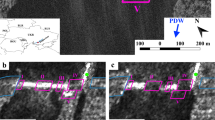Abstract
GEODETIC data, obtained by ground- or space-based techniques, can be used to infer the distribution of slip on a fault that has ruptured in an earthquake. Although most geodetic techniques require a surveyed network to be in place before the earthquake1–3, satellite images, when collected at regular intervals, can capture co-seismic displacements without advance knowledge of the earthquake's location. Synthetic aperture radar (SAR) interferometry, first introduced4 in 1974 for topographic mapping5–8 can also be used to detect changes in the ground surface, by removing the signal from the topography9,10. Here we use SAR interferometry to capture the movements produced by the 1992 earthquake in Landers, California11. We construct an interferogram by combining topographic information with SAR images obtained by the ERS-1 satellite before and after the earthquake. The observed changes in range from the ground surface to the satellite agree well with the slip measured in the field, with the displacements measured by surveying, and with the results of an elastic dislocation model. As a geodetic tool, the SAR interferogram provides a denser spatial sampling (100 m per pixel) than surveying methods1–3 and a better precision (∼3 cm) than previous space imaging techniques12,13.
This is a preview of subscription content, access via your institution
Access options
Subscribe to this journal
Receive 51 print issues and online access
$199.00 per year
only $3.90 per issue
Buy this article
- Purchase on Springer Link
- Instant access to full article PDF
Prices may be subject to local taxes which are calculated during checkout
Similar content being viewed by others
References
Blewitt, G. et al. Nature 361, 340–342 (1993).
Bock, Y. et al. Nature 361, 337–340 (1993).
Murray, M. H., Savage, J. C., Lisowski, M. & Gross, W. K. Geophys. Res. Lett. 20, 623–626 (1993).
Graham, L. C. Proc. Inst. elect. electron. Engrs 62, 763–768 (1974).
Zebker, H. & Goldstein, R. J. geophys. Res. 91, 4993–5001 (1986).
Gabriel, A. K. & Goldstein, R. M. Int. J. Remote Sensing 9, 857–872 (1988).
Li, F. K. & Goldstein, R. M. IEEE Trans. Geosci. Remote Sensing 28, 88–97 (1990).
Massonnet, D. Proc. int. Geophys. appl. Remote Sensing Symp. 2, 1431–1434 (1990).
Massonnet, O. Etude de Principe d'une Détection de Mouvements Tectoniques par Radar Internal memo No. 326 (Centre Nationale d'Etudes Spatiales, Toulouse, 1985).
Gabriel, A. K., Goldstein, R. M. & Zebker, H. A. J. geophys. Res. 94, 9183–9191 (1989).
Sieh, K. et al. Science 260, 171–176 (1993).
Crippen, R. E. Episodes 15, 56–61 (1992).
Crippen, R. E. & Blom, R. G. Eos (Supplement, 27 Oct.) 73, 364 (1992).
Kanamori, H., Thio, H.-K., Dreger, D. & Hauksson, E. Geophys. Res. Lett. 19, 2267–2270 (1992).
Okada, Y. Bull. seism. Soc. Am. 75, 1135–1154 (1985).
Shen, Z. Jackson, D., Feng, Y., Kim, M. & Cline, M. Bull. seism. Soc. Am. (submitted).
Jaumé, S. C. & Sykes, L. R. Science 258, 1325–1328 (1992).
Stein, R. S., King, G. L. P. & Lin, J. Science 258, 1328–1332 (1992).
Hill, D. P. et al. Science 260, 1617–1623 (1993).
Massonnet, D. & Rabaute, T. IEEE Trans. Geosci. Remote Sensing 31, 455–464 (1993).
Massonnet, D., Rossi, M. & Adragna, F. Paper presented at PRISME, CEOS workshop on SAR calibration, Oberpfaffenhofen, Germany, October 9–11 (1991).
Elassal, A. A. & Caruso, V. M. USGS Digital Cartographic Data Standards: Digital Elevation Models (National Cartographic Information Center, Reston, 1984).
Zebker, H. A. & Villasenor, J. IEEE Trans. Geosci. Remote Sensing 30, 950–959 (1992).
Cafforio, C., Prati, C. & Rocca, F. IEEE Trans. aero. Elect. Syst. 27, 194–207 (1991).
FRINGE SAR Interferometry Working Group, Proceedings of First Workshop, 12 Oct, 1992, Frascati, Italy (1992).
Gray, A. L. & Farris-Manning, P. J. IEEE Trans. Geosci. Remote Sensing 31, 180–191 (1993).
Author information
Authors and Affiliations
Rights and permissions
About this article
Cite this article
Massonnet, D., Rossi, M., Carmona, C. et al. The displacement field of the Landers earthquake mapped by radar interferometry. Nature 364, 138–142 (1993). https://doi.org/10.1038/364138a0
Received:
Accepted:
Issue Date:
DOI: https://doi.org/10.1038/364138a0
This article is cited by
-
All-optical free-space routing of upconverted light by metasurfaces via nonlinear interferometry
Nature Nanotechnology (2024)
-
Temporal stacking of sub-pixel offset tracking for monitoring slow-moving landslides in vegetated terrain
Landslides (2024)
-
Monitoring of landslide displacements in Owakudani, Hakone volcano, Japan, using SAR interferometry
Landslides (2024)
-
A review on advances in persistent scatterer interferometry and proposing a novel method for phase optimization of distributed scatterers pixels
Journal of Engineering Mathematics (2024)
-
Comparison of tropospheric delay correction methods for InSAR analysis using a mesoscale meteorological model: a case study from Japan
Earth, Planets and Space (2023)
Comments
By submitting a comment you agree to abide by our Terms and Community Guidelines. If you find something abusive or that does not comply with our terms or guidelines please flag it as inappropriate.



